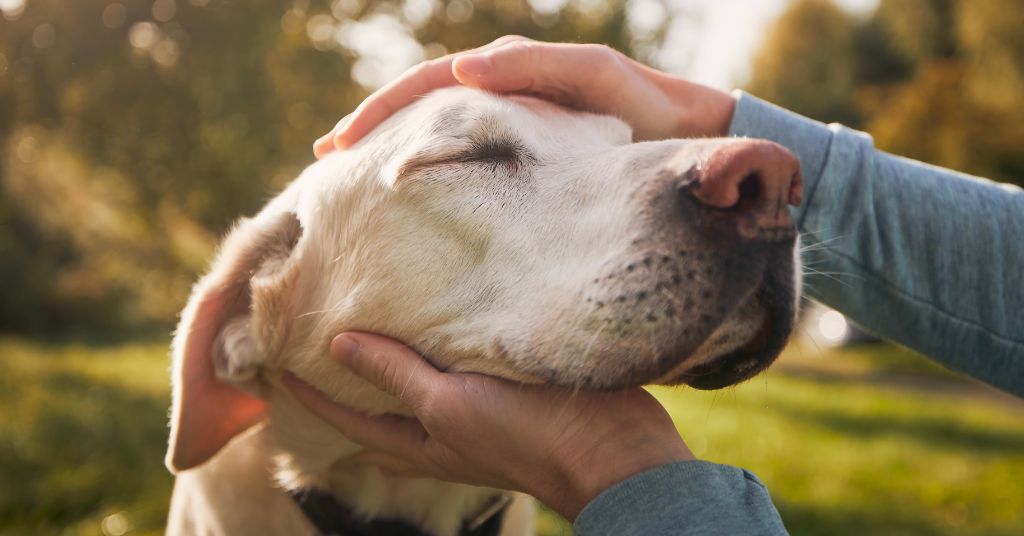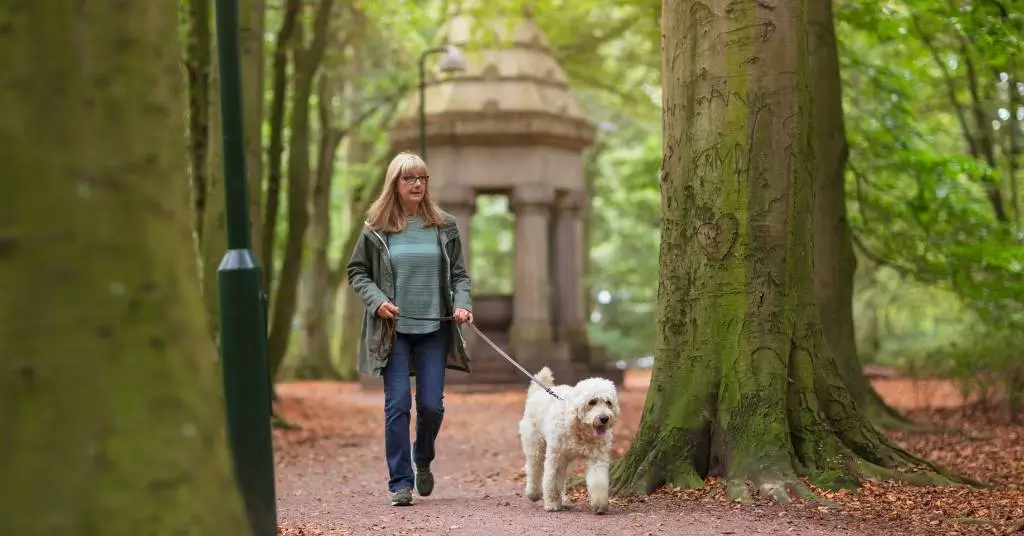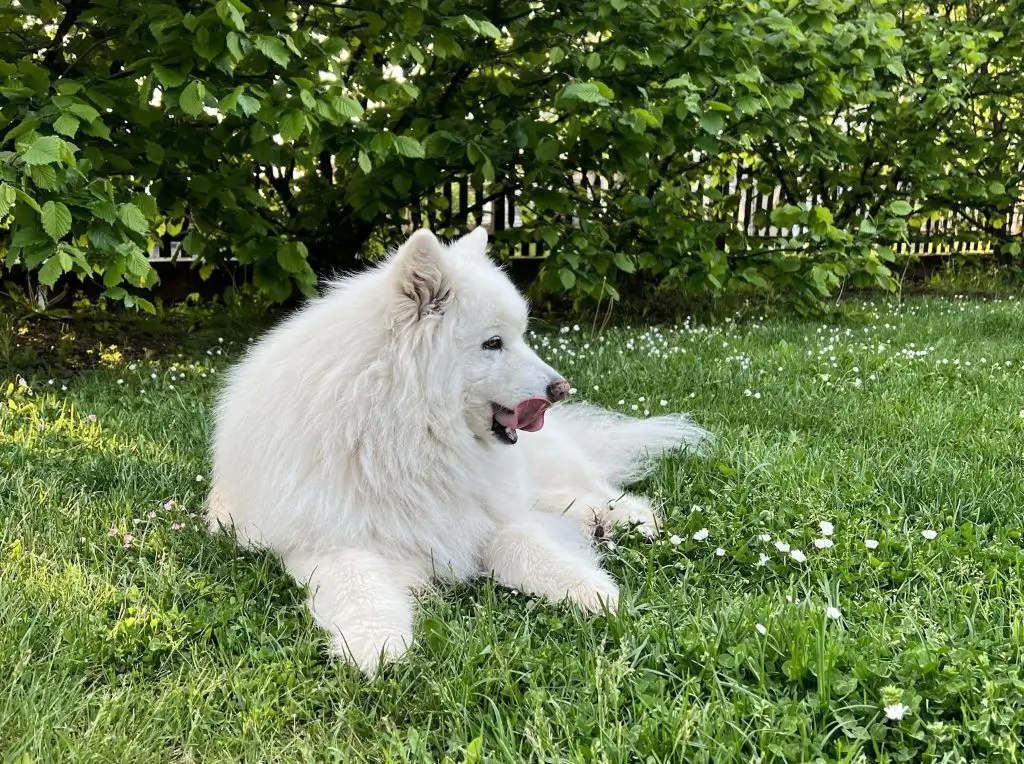Signs of Aging in Dogs You Have to Know About
This post shows you some of the most important Signs of Aging in Dogs You Have to Know About. It doesn’t happen overnight, but over time, we start noticing a few gray hairs, slower movements, and less energy. I want to help you spot the difference between normal aging and signs that could mean something more serious and show you a few simple ways to support your senior dog along the way.
While aging is inevitable, you can still do many things for your dog to help them age gracefully!

- Gray Hairs and Gray Whiskers
- Slower Movements and Stiff Joints
- Reduced Interest in Play or Exercise
- Bad Breath or Dental Issues
- Changes in Appetite or Eating Habits
- Changes in Sleep Patterns
- Weight Gain or Weight Loss
- Thinning Coat or Dry Skin
- Lumps, Bumps, or Skin Growths
- Behavioral Changes
- They Don't Handle Winter or Summer That Well
Gray Hairs and Gray Whiskers
Like us, dogs start having gray hair once they reach a certain age. Gray whiskers and hair are perfectly normal and don’t affect your dog’s sensory orientation or anything else.
Don’t cut your dog’s gray whiskers! Whiskers are important for dogs as they help them with orientation and help them move around.
Graying doesn’t have to mean that your dog is going through health issues. It just means they are losing the pigment and getting a bit older.
Slower Movements and Stiff Joints
This is one of the hardest things to witness, but once our dogs reach a certain age, they move a bit slower.
That doesn’t mean you’ll have to give up your walks and playdates—it just means your dog won’t have the same stamina to run for hours or walk long distances.
When you notice your dog slowing down, adjusting your pace is a good idea. Walk a little slower so they can keep up, and still give them plenty of time to sniff around and enjoy their walk.
Instead of playing fetch on the patio or a hard surface, try switching to grass or soft terrain. It gives their joints some cushion from all the jumping and running around.
Now, stiff joints are one of the most important signs of aging in dogs—and there’s actually a lot you can do to help them stay strong and comfortable.
How to Help Your Dog With Aging Joints?
Start with the basics: keep feeding them healthy food, take them on regular walks, offer enrichment, and make sure they don’t gain excess weight as they age!
You can also introduce more whole foods that naturally contain collagen, chondroitin, and glucosamine.
If you’re not sure where to begin, I wrote a simple but detailed guide that can help you pick the best foods for aging dogs.
In addition to a good diet, consider joint supplements. Talk to your vet first, but there are great natural options that can make a big difference.
Just a heads-up—joint supplements can take up to 8 weeks to show real effects (which is why I personally love starting with real food). The key is staying consistent and not giving up too soon.
If you want a shortcut to all the info in one place, don’t miss this guide where I break down which joint supplements actually work, why they help, and how to avoid wasting time and money.
As always, your vet can give tailored recommendations based on your dog’s age and condition. But in general, most joint supplements will help—as long as they include bioavailable ingredients your dog can actually absorb!
Reduced Interest in Play or Exercise

Similar to how they walk slower, move slower, and do everything a bit slowly, senior dogs may show a lack of interest in playing.
This is one of the saddest things to witness, but I promise it’s not the end of the world, and there are plenty of things you can do with your aging dog that don’t involve energetic play!
If you notice a slight change in your dog’s approach to playtime, then there’s nothing to worry about—it’s one of the normal signs of aging in dogs.
However, if the change is dramatic and sudden, then you should keep an eye out to see if something is off.
You can switch to gentle playtime, like playing hide and seek at home, where you hide their favorite toys (and leave some treats).
Then you can introduce more puzzle toys and puzzle feeders, as they are good for mental stimulation but don’t require tons of energy.
Lastly, you can go on new adventures and explore some new ways to spend quality time together.
It’s a bit silly, but I wrote about senior dog bucket list ideas that really don’t require lots of energy. I promise your dog will thank you for this one—check out these dog-friendly adventures that don’t require a lot of energy!
Bad Breath or Dental Issues
A dog’s breath usually smells (like fish and ocean), but it’s kind of a good smell, right?
Jokes aside, it’s not like they smell particularly fancy—of peppermint and sage—but if your dog’s breath suddenly starts smelling really foul, it’s not something you should shrug off. It could be a sign of dental problems.
One of the signs of aging in dogs is gum disease, which can be followed by loose teeth and infections. If these are not treated, they can affect the whole body, so you’d better get that checked out.
Unfortunately, even with regular dental care, we can’t prevent aging and losing teeth. So, if you notice that your dog is not a fan of chewy treats and toys, it could mean that they are simply getting older and that their teeth are getting sensitive.
What you can do is give them soft treats, toys, and food—and even make small bowls of mashed meat with veggies.
But if your dog is getting older and still enjoys chewing treats like dental chews and bully sticks, by all means, give them! They are important for their jaw muscles and for cleaning their teeth.
Changes in Appetite or Eating Habits
If your dog suddenly becomes super picky with what they eat, it doesn’t have to mean there’s a serious issue. Sometimes, it’s about feeling less hungry and simply needing less food.
In addition, as dogs get older, their sense of smell becomes a bit weaker, so they don’t smell the food like they used to.
As I said above, if their teeth are getting sensitive, that can also cause a change in appetite.
You should stick to their favorite food, high-quality commercial kibble, or any special diet that your vet recommends. Try introducing more home-cooked meals like cooked meat and veggies, and just experiment to see what your dog likes.
Changes in Sleep Patterns

It’s natural to sleep more as you get older, and it’s the same for our dogs.
Slowly, they start sleeping more during the day, taking longer naps, and sleeping later in the mornings. This is all normal for senior dogs!
If they are still acting as usual, then there’s nothing to worry about. They just need more sleep to rest, and that is fine.
However, if they start feeling a bit off—getting restless at night and struggling to sleep well throughout the night, followed by panting and difficulty breathing—that can indicate some sort of cognitive dysfunction, so you should visit your vet.
Weight Gain or Weight Loss
One of the most important signs of aging in dogs is sudden weight loss. That often means your dog has started losing muscle mass and now has to deal with more stress in the body.
Another thing that can happen as they age is their metabolism slowing down, so they can gain weight more easily.
That’s also not great for their joints, so you should do your best to optimize their meals (including portions) and introduce more foods that are good for volume eating! Think veggies and low-sugar fruits that they can eat without putting on pounds.
Thinning Coat or Dry Skin
As dogs get older, they start looking a bit more scruffy, with thinning hair around their nose, ears, and paws. Overall, they lose a bit of hair due to the normal aging process.
You might also notice some dry patches, rougher hair, and less shine than before.
There’s still plenty you can do to help them, though! Adding more fish to their diet can support hair and skin health, and including some supplements can help, too.
Also, don’t forget to groom and brush them regularly to get rid of dandruff and loose hair. They deserve to look gorgeous!
Lumps, Bumps, or Skin Growths
Aging is not fun for anyone, and our dogs are no exception. Just yesterday, I felt a small bump on my dog’s skin underneath his mane. It’s just a simple skin tag—totally harmless—but it wasn’t there before.
Skin changes are another common part of aging—random little lumps and bumps start showing up on their body.
Most of them are harmless, like skin tags. But if you notice a big lump underneath the skin, it’s better to get it checked out.
Keep an eye on size, color, and shape or if it starts bleeding. If anything changes quickly, that’s a sign it needs to be looked at again.
Try to check your dog’s body regularly during brushing or bath time so nothing goes unnoticed.
Behavioral Changes
Did your dog become a grumpy old man who likes to read his papers, comment on the economy, and criticize younger generations for buying too many lattes?
Jokes aside, behavioral changes are normal! Some dogs simply stop tolerating your frequent trips outside and need you with them all the time. They can become more clingy and needy and want to be with you constantly!
Some dogs, on the other hand, can really become a bit grumpy, wanting more peace and quiet.
Whatever happens, some behavioral changes are normal—and unfortunately, they usually happen because dogs start feeling physical discomfort.
They Don’t Handle Winter or Summer That Well

One of the signs of aging in dogs is the inability to regulate body temperature as well as they used to. So they start getting really cold in winter and easily overheat in summer.
My dog is not that old, but my parents’ Samoyed is 11 years old, and she started behaving really odd during the summer. As a double-coated dog, she really loves winter (after all, she is a Siberian Samoyed!), but starting last year, she started liking sunbathing!
She will lie in the hot weather, in direct sun, and lie on her back! Once, I had to carry her inside because it was mid-July, and we were sweating even with the AC on—but no, she liked it outside.
She still loves winter and sleeping in the snow, but I can definitely see her changing.
It’s all due to body temperature regulation.
So, in colder months, you can dress them up in jackets and coats and make sure your house is warm enough with cozy blankets and fluffy beds.
In summer, get them cooling pads and plenty of dog-friendly popsicle, and keep their water fresh.
Whatever happens, it’s our job to keep our dogs safe and healthy and to make everything easier for them! We learn so much from them during our time together. There’s a quiet wisdom that comes with senior dogs, and it only makes sense that we give back some of the love, patience, and care they’ve given us all along.
Which of these signs of aging in dogs did you notice in your dog? Let me know in the comments!
Don’t forget to pin this post so you’ll always have these pointers handy!
Love, life, and fur forever!
This post showed you Signs of Aging in Dogs You Have to Know About
You may also like: